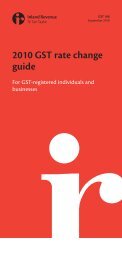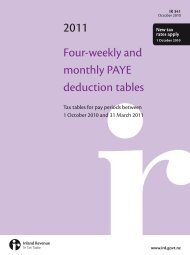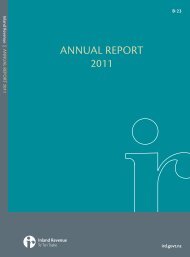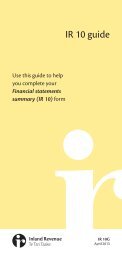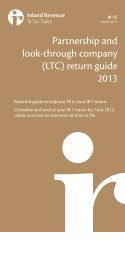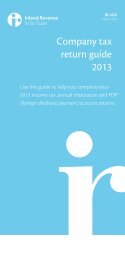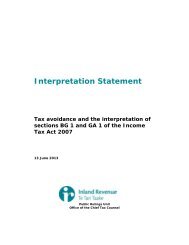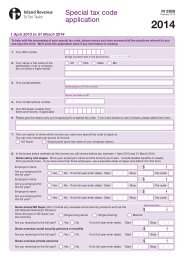Download - Inland Revenue Department
Download - Inland Revenue Department
Download - Inland Revenue Department
Create successful ePaper yourself
Turn your PDF publications into a flip-book with our unique Google optimized e-Paper software.
IR 44G<br />
March 2013<br />
Registered<br />
superannuation<br />
funds return guide<br />
2013<br />
Complete and send us your IR 44 return by<br />
7 July 2013, unless you have an extension of<br />
time to file—see page 5 of the guide.
2<br />
REGISTERED SUPERANNUATION FUNDS RETURN GUIDE<br />
www.ird.govt.nz<br />
Go to our website for information, services and tools.<br />
<br />
<br />
<br />
<br />
<br />
myIR Secure online services – log in to file your EMS,<br />
IR 3 or GST return or registration; manage your student<br />
loan; view your account balances and transactions; view<br />
or update your personal or family details and income,<br />
request or confirm your PTS and send us secure mail.<br />
Demonstrations – view online demonstrations of some<br />
of the tasks you can complete using your myIR secure<br />
online services ID and password.<br />
Get it done online – complete and send us forms and<br />
returns, make payments, make an appointment to see us<br />
and give us feedback.<br />
Work it out – use our calculators, worksheets and tools<br />
to help you manage your tax business like checking your<br />
tax code, or your filing and payment dates.<br />
Forms and guides – download our guides and fill in<br />
forms online, or download them to fill in and post to us.<br />
Some of our services now pre-fill your information, making<br />
it easier and faster to deal with us.<br />
How to get our forms and guides<br />
You can view copies of all our forms and guides by going<br />
to www.ird.govt.nz and selecting “Forms and guides”. You<br />
can also order copies by calling 0800 257 773.<br />
The information in this guide is based on current tax laws at<br />
the time of printing.
www.ird.govt.nz<br />
3<br />
Contents<br />
Page<br />
www.ird.govt.nz 2<br />
How to get our forms and guides 2<br />
Who has to file a return? 5<br />
Return due date 5<br />
Financial arrangements 5<br />
Questions 7<br />
Q 2 Name of fund 7<br />
Q 3 Postal address 7<br />
Q 5 Balance date 7<br />
Q 7 Final operating return 7<br />
Q 9 Investor funds 7<br />
Q 10 Transferring deductions 8<br />
Q 11 Taxable income 8<br />
Q 11L Tax payable 13<br />
Q 13 Foreign rights disclosure 13<br />
Q 14 Investment gains and losses 13<br />
Q 18B Overseas tax credit 14<br />
Q 18D Imputation credits 16<br />
Q 19 Refunds and/or transfers 16<br />
Q 20 Initial provisional tax liability 19<br />
Q 21 2014 provisional tax 20<br />
Payment dates 23<br />
How to make payments 25<br />
Late payment 26<br />
Interest rules 27<br />
For more help 27<br />
Self-assessment by taxpayers 27<br />
Services you may need 28<br />
0800 self-service numbers 28<br />
Postal addresses 29<br />
Customer service quality monitoring 29<br />
Privacy 29<br />
If you have a complaint about our service 30
www.ird.govt.nz<br />
5<br />
Who has to file a return?<br />
All superannuation funds registered with the Financial<br />
Markets Authority (formerly known as the Government<br />
Actuary) must file an IR 44 return. If your scheme isn't<br />
registered with the Financial Markets Authority and allows<br />
beneficiaries to contribute, it will be treated as a company<br />
for tax purposes and must file an IR 4. If the scheme doesn’t<br />
allow beneficiaries to contribute, it will be treated as a trust<br />
and must file an IR 6.<br />
Your fund may face penalties or prosecution if you:<br />
<br />
are required to put in a return but don’t<br />
<br />
<br />
give false or misleading information (including not<br />
showing correct income details)<br />
don’t take reasonable care in preparing the return.<br />
All questions in the return must be completed, unless your<br />
fund is an investor fund—see the note to Question 9 on<br />
page 7.<br />
The information on the first page of the return helps us to be<br />
sure that any correspondence we send goes to the right place.<br />
Return due date<br />
If the fund has a 31 March 2013 balance date you have until<br />
7 July 2013 to send in a return, unless you have an extension of<br />
time. If you have a balance date other than 31 March, the due<br />
date may be different. If you’re not sure, call us on 0800 377 774.<br />
If the fund has a tax agent you may have until 31 March<br />
2014 to file the return. Contact your agent for more<br />
information.<br />
Financial arrangements<br />
A superannuation fund must account for income from<br />
financial arrangements on either a cash or accrual basis<br />
provided they meet the criteria to use the cash basis<br />
method.
6<br />
REGISTERED SUPERANNUATION FUNDS RETURN GUIDE<br />
Financial arrangements include government stock, futures<br />
contracts and deferred property settlements. Changes to<br />
the rules for the treatment of financial arrangements have<br />
split the rules into two sets. Generally, the first set applies to<br />
financial arrangements entered into before 20 May 1999 and<br />
the second applies to financial arrangements entered into<br />
on or after 20 May 1999.<br />
Both sets of rules require the income or expenditure to be<br />
spread over the term of the financial arrangement.<br />
Sale or maturity of financial arrangements<br />
When a financial arrangement matures or is sold, remitted<br />
or transferred, a “wash-up” calculation, known as a base price<br />
adjustment, must be carried out. The calculation ensures<br />
the total gains or losses from the financial arrangement are<br />
brought to account.<br />
If you need any information on when losses can be<br />
deducted, or how to calculate a base price adjustment,<br />
please call us on 0800 443 773.
www.ird.govt.nz<br />
7<br />
Questions<br />
Question 2 Name of fund<br />
If the fund has changed its name since filing the last return<br />
please attach evidence of the name change, such as a letter<br />
of confirmation from the Financial Markets Authority.<br />
Question 3 Postal address<br />
If you have a new postal address write the details at<br />
Question 3. If your new postal address is a PO Box number,<br />
please show your box lobby if you have one. If you’re unsure<br />
of your box lobby please contact New Zealand Post.<br />
Leave this address panel blank if the fund uses its agent’s<br />
postal address. The agent will let us know of any change of<br />
address when updating their client list.<br />
Question 5 Balance date<br />
If your fund operates with a balance date other than<br />
31 March, we must give written consent for that date to be<br />
used for tax purposes. Send a written application, including<br />
full reasons, to the address on page 29 of this guide.<br />
Question 7 Final operating return<br />
If this is a final return, include a set of final accounts showing<br />
the distribution of all assets and liabilities to the date the<br />
fund was finalised.<br />
If the fund is registered for GST, or as an employer, you’ll<br />
also need to complete a Business cessation (IR 315) form to<br />
finalise your records.<br />
Question 9 Investor funds<br />
Special provisions apply if all the fund’s assets:<br />
<br />
consist of life insurance policies<br />
<br />
are invested in other superannuation funds.<br />
These funds are referred to in this guide as “investor funds”,<br />
and any fund they have invested in will be referred to as a<br />
“master fund”.
8<br />
REGISTERED SUPERANNUATION FUNDS RETURN GUIDE<br />
An investor fund that meets the conditions above will only<br />
need to complete:<br />
<br />
Questions 1 to 12, and<br />
<br />
the declaration at Question 22 on page 4 of the return.<br />
Question 10 Transferring deductions<br />
If a superannuation fund has invested in another<br />
superannuation fund, the second fund may claim certain<br />
expenses incurred by the first fund.<br />
The expenses can only be transferred to the second fund if<br />
the conditions of section DV2 of the Income Tax Act 2007<br />
are met.<br />
<br />
<br />
The expenses must relate to developing, marketing,<br />
selling, promoting or advertising for members to the<br />
fund, or management of the fund (but not expenses<br />
incurred in acquiring any plant, machinery, equipment,<br />
land or buildings, or expenses that are not income in the<br />
hands of the recipient).<br />
The first fund must make an election to transfer<br />
the expenses.<br />
If you want to transfer expenses, please show the details of<br />
the scheme and the amounts to be transferred in the table<br />
at Question 11 in the return.<br />
Question 11 Taxable income<br />
Write the fund’s income for tax purposes in Box 11. If this<br />
is a loss, put a minus sign in the last box, if the income is nil,<br />
show "0.00". Attach either:<br />
<br />
a fully completed Financial statement summary (IR 10)<br />
form, or<br />
<br />
a set of the fund’s financial accounts.
www.ird.govt.nz<br />
9<br />
Note<br />
The Financial statements summary (IR 10) is a short form<br />
of the financial statements of a business.<br />
Use an IR 10 and speed up processing of the return. We<br />
don’t need a set of accounts if you use an IR 10. You still<br />
need to complete a set of financial accounts and keep<br />
them in case we ask for them later.<br />
For help with filling out the IR 10, please see our IR 10<br />
guide that is available from our website at<br />
www.ird.govt.nz.<br />
Foreign investment fund (FIF) and controlled<br />
foreign company (CFC) income<br />
If at any time during the 2013 income year, the fund held<br />
rights such as shares, units, or an entitlement to benefit, in<br />
any foreign company, unit trust, superannuation scheme or<br />
life insurance policy, the fund may be required to calculate<br />
income from interests in a foreign company or an FIF.<br />
The main exclusions from an interest in an FIF are:<br />
<br />
<br />
<br />
investments in certain Australian resident companies<br />
listed on approved indices on the Australian stock<br />
exchange, that maintain franking accounts<br />
limited exemptions for interests in certain venture<br />
capital interests that move offshore for 10 income years<br />
from the income year in which the company migrates<br />
from New Zealand<br />
a 10% or greater interest in a CFC.<br />
The previous exemption for interests in grey list countries<br />
has been removed for interests of less than 10%.<br />
Guinness Peat Group plc (GPG)<br />
The exemption from the FIF rules has been removed for the<br />
2013 and future income years.<br />
If you previously applied the exemption to your GPG shares<br />
you now need to apply the FIF rules to this investment.
10<br />
REGISTERED SUPERANNUATION FUNDS RETURN GUIDE<br />
Generally, where the FIF rules apply, you use the fair<br />
dividend rate FIF income calculation method which requires<br />
you to identify the market value at the start of the income<br />
year. For more information on transition into the FIF rules go<br />
to http://www.ird.govt.nz/toii/fif/how-taxed/<br />
Further information on the exclusions and FIF rules is<br />
available at www.ird.govt.nz and in the Tax Information<br />
Bulletins (TIB).<br />
New rules have been introduced for calculating income or<br />
losses from a CFC. Funds with balance dates from 30 June<br />
to 30 September are required to apply the new rules from<br />
the beginning of the 2010 income year. All other funds are<br />
required to apply the new rules from the beginning of the<br />
2011 income year.<br />
Further information on the new CFC rules is available at<br />
www.ird.govt.nz and in the Tax Information Bulletin (TIB)<br />
Vol 21, No 8 (Oct/Nov 2009).<br />
What to show in your tax return<br />
At Question 11 include any income arising from an interest<br />
in a CFC or an FIF, including any taxable dividends.<br />
At Box 18B include any tax credits from a CFC or FIF.<br />
Convert all overseas income and tax credits to New Zealand<br />
dollars. You can do this in one of the following ways:<br />
<br />
<br />
<br />
<br />
use the rates table available on our website, (Keywords:<br />
overseas currencies)<br />
use the mid-month rate available from our leaflet<br />
Conversion of overseas income to New Zealand currency<br />
(IR 270)<br />
contact the overseas section of a trading bank and ask<br />
for the exchange rate for the day you received your<br />
overseas income<br />
refer to our currency conversion tables published in<br />
the May and November issues of our Tax Information<br />
Bulletin (TIB).
www.ird.govt.nz<br />
11<br />
Australian dividends<br />
The Taxation (GST, Trans-Tasman Imputation and<br />
Miscellaneous Provisions) Act 2003 has made it possible<br />
for Australian companies to pass on credit for tax paid in<br />
New Zealand to their shareholders.<br />
If you hold shares in an Australian company which has<br />
elected to maintain a New Zealand imputation account,<br />
you may see a “New Zealand imputation credit” on your<br />
dividend statement. It’s possible for dividends to be paid<br />
with these credits attached from 1 October 2003.<br />
Show any Australian dividend income at Question 11. Claim<br />
the “New Zealand imputation credits” in the dividend<br />
imputation credits box at Question 18D and include<br />
overseas tax credits at Question 18B.<br />
Please note this doesn’t mean Australian imputed or<br />
franking credits can now be claimed.<br />
Dividends received from companies qualifying for the<br />
Australian resident listed company exemption aren’t covered<br />
by the FIF rules. Further information on this and other<br />
exemptions is available at www.ird.govt.nz/toii/fif/<br />
Foreign-sourced dividends<br />
Under the FIF rules, dividends received from overseas<br />
companies aren't taxed separately in most instances.<br />
Generally, you would use the new default FIF income<br />
calculation method (fair dividend rate). However, the<br />
foreign tax deducted from the dividend can be claimed as a<br />
credit against the tax payable on the calculated FIF income.<br />
For more information about the FIF rules go to<br />
www.ird.govt.nz/toii/fif/<br />
Are you including any withdrawal tax at<br />
Question 11?<br />
If you are, print the liable amounts withdrawn in Box 12.
12<br />
REGISTERED SUPERANNUATION FUNDS RETURN GUIDE<br />
Investor funds<br />
Read the note to Question 9 on page 7 for an explanation of<br />
the terms “investor fund” and “master fund”.<br />
Where an investor fund’s income has been included in<br />
the master fund’s income tax return under “income”, the<br />
investor fund’s income at Question 11 will be “0.00”. In this<br />
situation the answer to Question 13 will be “No”.<br />
Filling in the adjustment boxes<br />
Boxes 11A and 11F – Transfers<br />
As explained in the note to Question 10 on page 8 certain<br />
expenses can be transferred between superannuation funds.<br />
If your fund is claiming expenses transferred from another<br />
fund, please enter the amount in Box 11A. If your fund<br />
has transferred the expenditure to another superannuation<br />
fund, complete the election details and show the amount of<br />
the transfer in Box 11F.<br />
Boxes 11B and 11G – Capital adjustments<br />
Where the resulting profits and/or losses have been treated<br />
as capital:<br />
<br />
<br />
deduct adjustments from the fund’s income (profits)<br />
and include them in Box 11B, and<br />
include adjustments to increase the fund’s income<br />
(losses) in Box 11G.<br />
Boxes 11C and 11H – <strong>Revenue</strong> adjustments<br />
Where the resulting profits and/or losses have been treated<br />
as revenue:<br />
<br />
<br />
deduct adjustments from the fund’s income (losses)<br />
and include them in Box 11C, and<br />
include adjustments to increase the fund’s income<br />
(profits) in Box 11H.
www.ird.govt.nz<br />
13<br />
Question 11L Tax payable<br />
2013 tax rates<br />
Fund type<br />
Tax rate<br />
Widely held funds and KiwiSaver scheme 28%<br />
Multi-rate PIEs will generally use their<br />
investors’ prescribed investor rate<br />
Maximum<br />
28%<br />
All other registered superannuation funds 33%<br />
Note: Funds that are multi-rate portfolio investment entities<br />
(PIEs) will need to ensure their tax isn’t recalculated to one<br />
of the other rates shown in the table.<br />
Question 13 Foreign rights disclosure<br />
If at any time during the 2013 income year, the fund calculated<br />
CFC or FIF income at Question 11 you may be required to<br />
complete an additional disclosure form for that investment.<br />
If the fund isn’t widely held or a PIE, additional disclosure<br />
isn’t required if the investments are in countries which<br />
New Zealand has a double tax agreement with, as at<br />
31 March 2013, and have used the fair dividend rate or<br />
comparative value method.<br />
If the fund is widely held or a PIE you are required to file an<br />
additional disclosure.<br />
If you need assistance making a CFC or FIF disclosure, please<br />
call 0800 377 774.<br />
For full details of the disclosure requirements go to<br />
www.ird.govt.nz (keywords: disclosure requirements).<br />
Question 14 Investment gains and<br />
losses<br />
Superannuation funds are subject to income tax on realised<br />
investment gains if:<br />
<br />
<br />
they are considered to be in the business of dealing in<br />
these investments, or<br />
the disposals were made in the ordinary course of<br />
business, or
14<br />
REGISTERED SUPERANNUATION FUNDS RETURN GUIDE<br />
<br />
the investments were purchased with the dominant<br />
purpose of resale.<br />
Realised investment losses will be allowed to the same extent.<br />
The legislative changes that introduced the fair dividend rate<br />
FIF calculation method and the new PIE, mean these gains<br />
are no longer subject to income tax. Further information<br />
is available in the Tax Information Bulletin (TIB) Vol 19, No 3<br />
and No 6.<br />
Question 18B Overseas tax credit<br />
Include in Box 18B any credit for tax paid overseas, including<br />
tax credits from a CFC or FIF.<br />
Credit for tax paid overseas is limited to the lesser of:<br />
<br />
the New Zealand tax payable on the overseas income<br />
<br />
the actual overseas tax paid.<br />
Work out the New Zealand tax payable as follows:<br />
overseas income (NZ$)<br />
taxable income (Box 11K)<br />
x<br />
total tax<br />
payable<br />
(Box 18A)<br />
=<br />
New Zealand<br />
tax payable<br />
on overseas<br />
income<br />
Write the lesser of this amount and the actual overseas tax<br />
paid in Box 18B.<br />
Claiming overseas tax paid on offshore dividends<br />
You can claim the tax credits up to the amount of<br />
New Zealand income tax payable on the FIF income<br />
associated with the attributing interest that has paid the<br />
dividend. If you’ve used the fair dividend rate method then<br />
the tax credits would offset the tax payable on the fair<br />
dividend rate income associated with that attributing interest.<br />
Where there is no FIF income or an FIF loss<br />
Tax paid overseas can only be used to cover your liability<br />
for income tax payable on your FIF income. If there is no<br />
New Zealand income tax payable on your FIF investment,<br />
no claim can be made for the overseas tax paid on any<br />
dividends received from that FIF. You cannot get a refund<br />
of overseas tax paid, or reduce tax payable on any other
www.ird.govt.nz<br />
15<br />
income. For more information read A guide to foreign<br />
investment funds and the fair dividend rate (IR 461).<br />
Note<br />
Franking credits on Australian dividends and tax shown<br />
on United Kingdom dividends can’t be claimed.<br />
Unused foreign tax credits<br />
These are generally forfeited (lost).<br />
Carrying forward any excess or unused foreign<br />
tax credits?<br />
You can't carry forward unused foreign tax credits where<br />
you have used the fair dividend rate, comparative value,<br />
deemed rate of return or cost methods to calculate FIF<br />
income or loss.<br />
New Zealand tax credits (imputation or RWT)<br />
deducted from overseas dividends<br />
As they are New Zealand tax credits they can be claimed as<br />
follows:<br />
<br />
<br />
If the credits are RWT (resident withholding tax)<br />
they are used to offset tax payable with any excess<br />
refundable.<br />
If they are imputation credits they are used to reduce<br />
tax payable with any excess converted to a loss to carry<br />
forward to next year.<br />
The full amount of these New Zealand tax credits can be<br />
entered in the return even where the FIF income is reduced<br />
to zero or there is an FIF loss.<br />
These credits will only be attached to Australian company<br />
or unit trust dividends.<br />
Investments in portfolio investment entities<br />
(PIEs)<br />
Certain PIEs attribute the net income/loss and tax credits<br />
they derive across their investors. Investors that are funds<br />
include the attributed income or loss and tax credits in their<br />
tax return.
16<br />
REGISTERED SUPERANNUATION FUNDS RETURN GUIDE<br />
Each year the PIE is required to provide an investor statement<br />
setting out the details of the income/loss attributed to the<br />
investor for the year. The statement also shows the various<br />
types of tax credits associated with the income attributed.<br />
These tax credits are subject to the tax credit limits<br />
calculated in relation to the tax on the attributed PIE income.<br />
The PIE income/loss is included in the fund’s return for the<br />
period including the end of the PIE’s income year. Generally,<br />
PIEs will have a 31 March balance date. The amount of<br />
income derived by the fund as a distribution by a PIE, is<br />
excluded income of the fund other than fully imputed<br />
dividends from a PIE that is a listed company.<br />
If the fund is a PIE it will need to comply with the requirements<br />
under subpart HM of the Income Tax Act 2007.<br />
Question 18D Imputation credits<br />
If the fund received imputation credits, it may have a net loss<br />
to carry forward. This will happen if the imputation credits<br />
are greater than the total tax payable amount at Box 18C.<br />
To calculate the net loss to carry forward, subtract the total<br />
tax payable (Box 18C) from the total imputation credits<br />
(Box 18D). Divide the answer by the relevant tax rate,<br />
ie, 0.33 (33%) or 0.28 (28%). Carry the net loss forward to<br />
the 2014 return. We'll send you a notice confirming the<br />
amount to carry forward to the fund’s 2014 tax return.<br />
Question 19 Refunds and/or transfers<br />
If you’re entitled to a refund you can:<br />
<br />
transfer it to arrears that are being paid off<br />
<br />
transfer all or part of it to your 2014 provisional tax<br />
<br />
have it direct credited to a bank or other deposit<br />
account, eg, a building society account.<br />
If you’ve made payments towards your 2014 provisional tax<br />
and, after completing this return, find you have less or no<br />
provisional tax to pay, the overpayment can be included<br />
in the amount we refund or transfer. Print the overpaid<br />
amount in Box 19A.
www.ird.govt.nz<br />
17<br />
Refunds of less than $5<br />
If your refund is less than $5 it will be carried forward to<br />
your next tax assessment. We’ll offset it against any amount<br />
you may owe us or add it to any refund. If you don’t want it<br />
carried forward, please call us on 0800 377 774.<br />
Box 19H – refund by cheque<br />
If you want to receive any refund by cheque, tick Box 19H.<br />
Transfers<br />
If you’d like your refund (“the credit”) transferred to another<br />
account or to arrears you’re paying off by an instalment<br />
arrangement, you’ll need to tell us what date you’d like it<br />
transferred. The date you choose depends on what tax has been<br />
overpaid and whose account you want the credit transferred to.<br />
If the transfer is to arrears being paid off through an<br />
instalment arrangement, you’ll need to include a note with<br />
your return, authorising the transfer. Please state clearly:<br />
<br />
<br />
<br />
<br />
<br />
that the transfer is to arrears currently under an<br />
instalment arrangement<br />
the name and IRD number of the taxpayer the transfer<br />
should be made to<br />
whether the taxpayer is an “associated taxpayer”<br />
the tax type and period<br />
the date you’d like the transfer to take place.<br />
Associated taxpayers<br />
When transferring overpaid tax, “associated taxpayers” are:<br />
<br />
a company you’re a shareholder-employee in<br />
<br />
a partner in the same partnership<br />
<br />
a relative (eg, child, parent, spouse, or partner)<br />
<br />
a trustee of a family trust you’re a beneficiary of.<br />
You can ask for your credit to be transferred at any date as<br />
long as it’s not before the relevant date shown below.
18<br />
REGISTERED SUPERANNUATION FUNDS RETURN GUIDE<br />
Transfer date<br />
For credit transferred to your account or an associated<br />
person’s account:<br />
<br />
<br />
<br />
If the credit is from excess tax deducted (eg, PAYE<br />
deducted) it’s the day after your balance date (or 1 April<br />
if your balance date is before 31 March).<br />
If the credit is from overpaid provisional tax it’s the day<br />
you overpaid it.<br />
For credit transferred to a non-associated person’s<br />
account, it’s the later of the day you requested the<br />
transfer, or the day after you file your return.<br />
Future transfer dates<br />
If you’d like your credit transferred at a date in the future,<br />
attach a note to the front of your return with details of:<br />
<br />
the amount you want transferred<br />
<br />
<br />
the account you want it transferred to, and if it’s the<br />
account of an associated person<br />
the date you’d like it transferred.<br />
If you don’t tell us the date you’d like your credit transferred,<br />
we’ll transfer it at a date we think gives you the greatest<br />
advantage. Contact us if you’d like to change the transfer<br />
date and tell us if this transfer is to cover a debt.<br />
Requesting transfers on the return<br />
Fill out the boxes on page 4 of your return if you’d like to<br />
transfer a credit to another account.<br />
Transfer date<br />
For credit transferred to your account or an associated<br />
person’s account, it’s the later of the day after your balance<br />
date (or 1 April if your balance date is before 31 March), or<br />
the due date in the account it’s going to.<br />
For credit transferred to the account of a non-associated<br />
person, it’s the day after you file your return.
www.ird.govt.nz<br />
19<br />
Contact us if you’d like to change the transfer date. Include<br />
the details of the account you want the credit to be<br />
transferred to and, if it’s going to another person, tell us the<br />
transfer date.<br />
Question 20 Initial provisional tax<br />
liability<br />
A fund has an initial provisional tax liability for a tax year if:<br />
<br />
<br />
it started to derive income from a taxable activity in the<br />
tax year, and<br />
had not derived gross income from a taxable activity<br />
within the preceding four years.<br />
However, there is no obligation to pay provisional tax in the<br />
year that the fund has an initial provisional tax liability if the<br />
residual income tax for the current and/or previous year was<br />
$2,500 or less.<br />
Some new businesses make voluntary payments to mitigate<br />
interest liabilities. For more information please read our<br />
guide Provisional tax (IR 289).<br />
Print the date the fund started to derive income from the<br />
taxable activity in Box 20.<br />
Interest rules for initial provisional tax liability<br />
If you have an initial provisional tax liability, you may be<br />
charged interest from the first, second or third instalment<br />
date. The instalment date interest applies from is<br />
determined by the business start date.<br />
More information about an initial provisional tax liability<br />
and the dates that interest applies from is available in our<br />
guide Provisional tax (IR 289).<br />
There are special rules about how interest is calculated when<br />
a fund has an initial provisional tax liability and has changed<br />
its balance date. For further information please refer to our<br />
Tax Information Bulletins (TIB).
20<br />
REGISTERED SUPERANNUATION FUNDS RETURN GUIDE<br />
Question 21 2014 provisional tax<br />
2014 provisional tax is charged for income the fund will<br />
earn in the 2014 income year. It’s payable in two, three or<br />
six instalments. There are three options for calculating your<br />
provisional tax—standard, estimation and ratio.<br />
If the fund’s 2013 residual income tax (RIT) is:<br />
<br />
<br />
<br />
$2,500 or less it does not have to pay provisional tax,<br />
but it can make voluntary payments<br />
more than $2,500 but expected to be $2,500 or less<br />
for 2014, it may estimate 2014 provisional tax at nil<br />
more than $2,500 and expected to be more than<br />
$2,500 for 2014, it must pay 2014 provisional tax using<br />
one of the payment options.<br />
Residual income tax (Box 18G) is the amount remaining<br />
after deducting all credits except provisional tax payments.<br />
Which option to use<br />
There are three income tax rates that apply to funds (see to<br />
page 12). Funds with the 33% tax rate that is not changing<br />
for the 2014 income year will have general provisional<br />
tax rules applied. The other two categories of funds will<br />
qualify for the new rules. All funds may choose one of the<br />
following three options:<br />
Standard option<br />
2014 provisional tax is the 2013 RIT amount plus 5%. If<br />
you use this option, write S in Box 21 of the return and the<br />
amount of 2014 provisional tax in Box 21A.<br />
If the fund’s 2013 return hasn’t been filed by the first<br />
instalment of 2014 provisional tax, the provisional tax is the<br />
2012 RIT plus 10%.
www.ird.govt.nz<br />
21<br />
Exception: Widely held funds<br />
Widely held saving vehicles pay income tax at the company<br />
rate of 28%.<br />
If your 2013 return is not filed by the due date for the first<br />
instalment of the 2014 provisional tax, the provisional tax is<br />
the 2012 RIT amount plus 5%.<br />
More information on the new tax rate and how it affects<br />
provisional tax is available in our guide Provisional tax<br />
(IR 289) and our Tax Information Bulletin (TIB) Vol 22, No 7<br />
(August 2010).<br />
Estimation option<br />
Your fund can estimate its 2014 provisional tax any number<br />
of times up to its third instalment due date. If its 2014 RIT<br />
is expected to be less than the 2013 tax, estimating may<br />
prevent the fund from paying more than it has to.<br />
If you estimate its provisional tax, write E in Box 21 and the<br />
amount of 2014 provisional tax in Box 21A. The instalments<br />
should be one-third of your estimation. If you’re using<br />
the ratio option and select E at Box 21 this means you’re<br />
electing to stop using the ratio option.<br />
Ratio option<br />
If you’re GST registered, you may qualify to use the ratio<br />
option to calculate your provisional tax.<br />
Only enter R at Box 21 if you’ve already elected to use the<br />
ratio option. You must apply to use the ratio option by<br />
phone or in writing before the beginning of the income year<br />
you wish to use it in.<br />
If you’ve already elected to use the ratio option and want to<br />
continue using it, enter R at Box 21.<br />
More information about the ratio option is available in our<br />
guide Provisional tax (IR 289).
22<br />
REGISTERED SUPERANNUATION FUNDS RETURN GUIDE<br />
Interest<br />
Generally, if the fund has paid too much provisional tax we<br />
pay interest, or if it hasn’t paid enough provisional tax we<br />
charge interest.<br />
Interest the fund pays is tax deductible, while interest we<br />
pay is taxable income.<br />
Note<br />
Interest will continue to accrue until the tax has been<br />
paid. You can stop any more interest accruing on the<br />
fund’s account by paying the total tax assessed for the<br />
period the interest was charged. If the fund has been<br />
charged interest, it should be paid by the due date for<br />
payment of tax.<br />
Election to be a provisional tax payer<br />
A fund is a provisional tax payer for the 2013 year if its RIT<br />
for that year is more than $2,500. If the 2013 RIT is $2,500 or<br />
less but the fund paid provisional tax for the year, the fund<br />
may elect to be a provisional tax payer for that year, which<br />
may affect the interest the fund is entitled to.<br />
To elect to be a provisional tax payer for the 2014 year,<br />
attach a note to the front of the 2013 return.<br />
Change in balance date<br />
There are special rules about when provisional tax is due and<br />
how interest is calculated if there has been a change in the<br />
balance date.<br />
Penalty for not taking reasonable care<br />
When you estimate the fund’s 2014 provisional tax, your<br />
estimate must be fair and reasonable. If the 2014 RIT is<br />
greater than the provisional tax paid, you may be liable for a<br />
penalty which is 20% of the underpaid provisional tax.
www.ird.govt.nz<br />
23<br />
For more information:<br />
<br />
on interest and penalties, read our guide<br />
Taxpayer obligations, interest and penalties (IR 240)<br />
<br />
on provisional tax, read our guide Provisional tax (IR 289).<br />
Tax pooling<br />
Tax pooling allows taxpayers to pool provisional tax<br />
payments, offsetting underpayments by overpayments<br />
within the same pool, and reducing their possible exposure<br />
to late payment penalties and use-of-money interest.<br />
The pooling arrangement is made through a commercial<br />
intermediary, who arranges for participating taxpayers to be<br />
charged or compensated for the offset.<br />
For more information about tax pooling, including a list<br />
of intermediaries, go to www.ird.govt.nz (Keywords: tax<br />
pooling).<br />
Payment dates<br />
2014 provisional tax<br />
Generally, a fund with a 31 March balance date pays<br />
provisional tax by the following due dates:<br />
First instalment 28 August 2013<br />
Second instalment 15 January 2014<br />
Third instalment 7 May 2014<br />
A fund with a balance date other than 31 March generally<br />
pays provisional tax on the 28th day of the 5th, 9th and 13th<br />
months after the balance date.<br />
There are two exceptions:<br />
<br />
<br />
Payments that would otherwise be due on 28 December<br />
are payable on 15 January.<br />
Payments that would otherwise be due on 28 March are<br />
payable on 7 May.
24<br />
REGISTERED SUPERANNUATION FUNDS RETURN GUIDE<br />
These dates will alter if:<br />
<br />
<br />
<br />
the fund is registered for GST, and<br />
the GST filing frequency is six-monthly, or<br />
provisional tax is paid by the ratio option.<br />
If any of these situations apply to you, read our guide<br />
Provisional tax (IR 289).<br />
2013 end-of-year income tax<br />
Funds that have an agent and an extension of time may<br />
have until 7 April 2014 to pay their tax. If you think this<br />
applies, contact your agent.<br />
Otherwise, a fund with a balance date between 1 March and<br />
30 September must pay its end-of-year income tax and any<br />
interest by 7 February 2014.<br />
A fund with a balance date between 1 October and<br />
28 February must pay its end-of-year income tax by the<br />
7th day of the month before the following year’s balance<br />
date.
www.ird.govt.nz<br />
25<br />
How to make payments<br />
You can make payments:<br />
<br />
<br />
<br />
<br />
electronically<br />
at a Westpac branch by cheque or electronically<br />
by credit or debit card on our website<br />
by using our drop box.<br />
Electronic payments are made through your bank by:<br />
<br />
<br />
<br />
automatic payment<br />
online banking<br />
direct credit.<br />
When making electronic payments, include:<br />
<br />
<br />
<br />
your IRD number<br />
a tax type code, eg, INC for income tax<br />
the period the payment is for.<br />
For full details on payment options go to<br />
www.ird.govt.nz (keywords: making payments) or read our<br />
guide Making payments (IR 584).<br />
Paying online by credit or debit card<br />
You can also make all your online payments by credit or<br />
debit card. Our bank, Westpac New Zealand, charges a<br />
1.42% convenience fee on each transaction. You won't have<br />
to pay this fee if you're making overseas payments for a<br />
student loan or non-custodial child support.<br />
For full details on paying online go to www.ird.govt.nz<br />
and select “Make a payment” or read our guide Making<br />
payments (IR 584).
26<br />
REGISTERED SUPERANNUATION FUNDS RETURN GUIDE<br />
Late payment<br />
We will charge you interest if you don’t make your tax<br />
payment by the due date. We may also charge you a late<br />
payment penalty if you miss a payment. If you have a good<br />
payment history with us we may contact you before we do<br />
this.<br />
If your tax remains unpaid, we’ll charge an initial 1% late<br />
payment penalty on the day after the due date. We’ll charge<br />
a further 4% penalty if there’s still an amount of unpaid tax<br />
(including penalties) seven days after the due date.<br />
Every month the amount owing remains unpaid after the<br />
due date we’ll charge a further 1% incremental penalty.<br />
Interest and late payment penalties are not charged on<br />
outstanding amounts of $100 or less.<br />
Arrangements<br />
If you’re unable to pay your tax by the due date, please<br />
call us. We’ll look at your payment options, which may<br />
include an instalment arrangement, depending on your<br />
circumstances. Arrangements can be agreed on, before or<br />
after the due date for payment. There are greater reductions<br />
in the penalties charged if the arrangement is made before<br />
the due date. You can send us an instalment arrangement<br />
proposal online. Go to www.ird.govt.nz (keyword:<br />
arrangement).<br />
For more help<br />
See our guide Taxpayer obligations, interest and penalties<br />
(IR 240).
www.ird.govt.nz<br />
27<br />
Interest rules<br />
Your fund will be charged interest if it has more than $100<br />
unpaid tax (including any late payment penalties) after the<br />
payment due date.<br />
If your fund overpays its tax by more than $100 we may pay<br />
you interest.<br />
Where a return has a credit at Box 18G, interest starts on the<br />
later of the following:<br />
A The day after the due date for payment<br />
B The day after the date payment was made<br />
C The day after the return was lodged.<br />
For more help<br />
If you have any questions about tax for superannuation<br />
funds, please contact:<br />
Assistance<br />
Large Enterprises<br />
Private Bag 39984<br />
Wellington Mail Centre<br />
Lower Hutt 5045<br />
Phone 0800 443 773<br />
Fax<br />
04 890 4502<br />
Self-assessment by taxpayers<br />
Taxpayers have to assess their own liability as part of their<br />
return filing obligations. We may amend your assessment if<br />
a correction is required.<br />
If you dispute our assessment please read our factsheet If<br />
you disagree with an assessment (IR 778). The four-month<br />
period for you to issue a notice of proposed adjustment<br />
(NOPA) to your self-assessment will start on the date <strong>Inland</strong><br />
<strong>Revenue</strong> receives your return.
28<br />
REGISTERED SUPERANNUATION FUNDS RETURN GUIDE<br />
Services you may need<br />
0800 self-service numbers<br />
This service is available seven days a week (any time, except<br />
between 5 am and 6 am) for a range of self-service options.<br />
Remember to have your IRD number with you when you call.<br />
For access to individuals’ personal information, such as<br />
account balances, you'll need to be enrolled for voice ID or<br />
have a personal identification number (PIN). You can enrol<br />
for voice ID by calling 0800 257 843 and reset an existing PIN<br />
by calling 0800 257 777.<br />
Order publications and taxpacks 0800 257 773<br />
Request a summary of earnings 0800 257 778<br />
Request a personal tax summary 0800 257 444<br />
Confirm a personal tax summary 0800 257 771<br />
All other services 0800 257 777<br />
When you call our self-service numbers, we’ll ask you to<br />
say why you’re calling. Our speech recognition system will<br />
then direct you to a self-service line where you can get the<br />
information you want. If you need to talk to us, your call<br />
will go direct to an advisor who has the specific information<br />
to help you.
www.ird.govt.nz<br />
29<br />
Postal addresses<br />
Payments<br />
<strong>Inland</strong> <strong>Revenue</strong><br />
PO Box 39050<br />
Wellington Mail Centre<br />
Lower Hutt 5045<br />
General correspondence<br />
<strong>Inland</strong> <strong>Revenue</strong><br />
PO Box 39010<br />
Wellington Mail Centre<br />
Lower Hutt 5045<br />
Returns<br />
<strong>Inland</strong> <strong>Revenue</strong><br />
PO Box 39090<br />
Wellington Mail Centre<br />
Lower Hutt 5045<br />
For a full list of addresses go to www.ird.govt.nz/contact us.<br />
Customer service quality monitoring<br />
As part of our commitment to providing you with a quality<br />
service, we may record phone calls to and from our contact<br />
centres. Find out more about this policy or how to access<br />
your recorded information at www.ird.govt.nz (keywords:<br />
call recording).<br />
Privacy<br />
Meeting your tax obligations means giving us accurate<br />
information so we can assess your liabilities or your<br />
entitlements under the Acts we administer. We may charge<br />
penalties if you don’t.<br />
We may also exchange information about you with:<br />
<br />
<br />
<br />
some government agencies<br />
another country, if we have an information supply<br />
agreement with them<br />
Statistics New Zealand (for statistical purposes only).<br />
If you ask to see the personal information we hold about<br />
you, we’ll show you and correct any errors, unless we have<br />
a lawful reason not to. Call us on 0800 377 774 for more<br />
information. For full details of our privacy policy go to<br />
www.ird.govt.nz (keyword: privacy).
30<br />
REGISTERED SUPERANNUATION FUNDS' RETURN GUIDE<br />
If you have a complaint about our<br />
service<br />
We’re committed to providing you with a quality service. If<br />
there’s a problem, we’d like to know about it and have the<br />
chance to fix it. You can call the staff member you’ve been<br />
dealing with or, if you’re not satisfied, ask to speak with their<br />
team leader/manager. If your complaint is still unresolved<br />
you can contact our Complaints Management Service.<br />
For more information go to www.ird.govt.nz (keyword:<br />
complaints) or call us on 0800 274 138 between 8 am and<br />
5 pm weekdays.<br />
If you disagree with how we’ve assessed your tax, you<br />
may need to follow a formal disputes process. For more<br />
information, read our factsheet, If you disagree with an<br />
assessment (IR 778).



